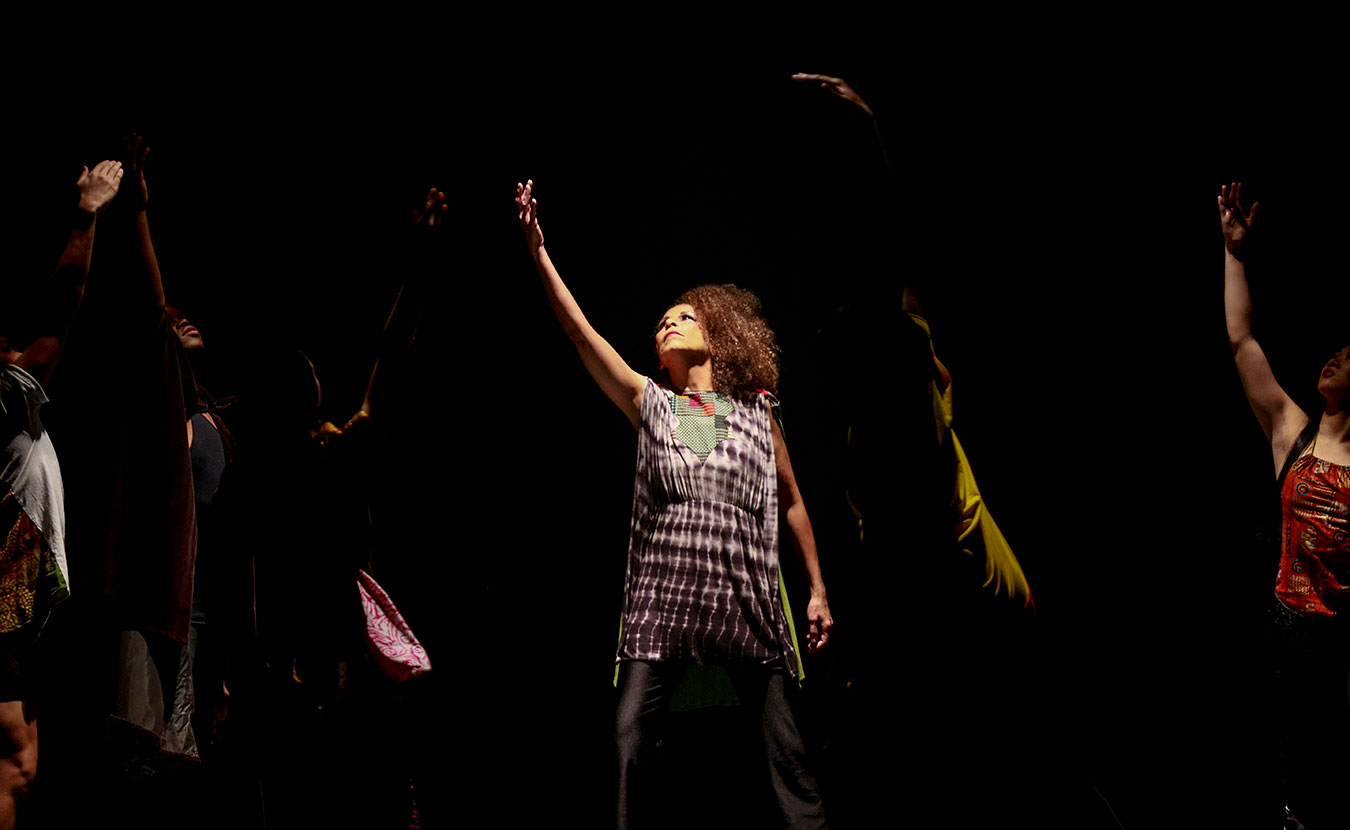“When I dance, I believe I am a messenger of the gods,” says Kim Morris Newson, 62, longtime dancer and 15-year member of Indiana University’s African American Dance Company (AADC). “I see dance as being used as communication between body and soul, to express what is too deep to find [with] words.”
Dance, says Morris Newson, is her “shortcut to happiness.” She dreamed of being a dancer from a young age, but because of financial limitations she wasn’t able to study it until college. Soaking in the art, Morris Newson took every genre she could: jazz, hip-hop, modern, ballet, tap, and cultural dances. “I fell in love with the art of dance — communication without words,” she remembers.
With an experience similar to other women in the Bloomington community, Morris Newson found a space in dance where she connected her body and mind, expressed herself, and gained confidence.
In a world where women’s voices are undervalued, dance companies in Bloomington — whether exclusively for women or not — provide an invaluable opportunity for women to cultivate self-love, build friendships and connections, and find the necessary space for stress relief.

Professor Iris Rosa, who founded AADC and was the director for 43 years, performs in Potpourri of the Arts. | Photo courtesy of African American Arts Institute
Research shows dance produces numerous mental and physical health benefits, and according to Caroline Young and Cyndie Koopsen, authors of Spirituality, Health and Healing: An Integrative Approach, the art form is an integral part of cultures around the world, a custom known to heal, promote health, and cultivate energy. The increased awareness of dance therapy’s potential demonstrates society is finally taking its merits seriously — something the women dancers of Bloomington have long known.
Iris Rosa, a professor and director of Undergraduate Studies in the Department of African American and African Diaspora Studies at IU, founded the AADC in 1974 and was the director for 43 years. She says dance is part of “how people live and express through the ages” and, especially in African diasporic culture, cannot be separated from other parts of culture such as music and art. In a community that values creative expression as Bloomington does, it’s no surprise dance is an integral part of the artistic scene — and isn’t limited to the strict performative aspect of the medium, either.
When Jaclyn Hadfield, an IU Ph.D. student in health behavior, moved to Bloomington in 2014, she found herself surrounded by talented community members and artists and knew it was the ideal place to develop an all-women dance company.
Hadfield, who grew up dancing and studied dance while pursuing her bachelor’s degree, was disappointed that “once you’re at a certain point in adulthood there are no longer options for you to continue learning dance, or continuing performing, that don’t make you feel like less of a dancer.”
Now in its third year, Echo Dance Company not only provides a way for women to continue exploring their technique and skills, but at its core also works to “bring an echo of inspiration within the soul through a worthwhile goal,” says Hadfield.

Jaclyn Hadfield, foreground, is the director and lead choreographer of Echo Dance Company. | Photo courtesy of Kelvin Burzon
Hadfield started Echo to unite likeminded women and encourage them in all aspects of life, but her role as director and lead choreographer brings confidence and joy to her life as well. For Hadfield, dance is something her body “craves,” and helps her problem solve through a different lens and utilize creativity outside her academic program.
“Every individual has the right to understand how to move their body and all the things that it can do for them,” Hadfield says.
In the context of movements like #MeToo, where millions of women have come out with stories of sexual harassment and assault, dance helps women reclaim their autonomy and reject society’s harsh criticism of their bodies.
In their article for British Journal of Guidance & Counseling and on the American Psychological Association website, “Coming alive: Creative movement as a personal coping strategy on the path to healing and growth,” Joanna Leseho and Lisa Rene Maxwell write, “In a culture that values its own narrow definition of beauty, participation in expressive dance or another dance form has the ability to facilitate a healthier relationship to one’s body which, in turn, positively affects one’s psychological and physical health. Through dance or creative movement, women learn to differentiate who they are from their physical appearance.”
With professional dancers often stereotyped as experiencing eating disorders, the idea that the art can help a woman’s body image seems counterintuitive. But in Bloomington, dance companies are welcome spaces for all.
Alison Sinadinos is a 32-year-old graduate student and member of Echo Dance Company. Having danced nearly every style — jazz, hip hop, modern, lyrical — and throughout her adolescence and into adulthood, she was once discouraged from continuing after a teacher told her she was “too heavy” to be a dancer. She says many other dancers grew up hearing similar ideas.

Alison Sinadinos says, “Echo gave me the space to be me.” | Courtesy photo
But in Echo — coinciding with the environment Hadfield aims to create — Sinadinos finds a welcoming, supportive place where Hadfield’s choreography “appreciates all people and highlights their strengths.”
“Echo gave me the space to be me — to live my life authentically without fear of judgment,” says Sinadinos.
IU’s African American Dance Company brings together students and community members to learn and respect the culture and traditions of African diasporic cultures forming the United States, Africa, and the Caribbean triad. In groundbreaking creativity, the company brings interdisciplinary collaborations with an African diasporic perspective — one that is often left out of other arenas.
While exploring movement, history, and culture through this lens, AADC’s members also work in collaboration in a radically body-positive space. Whereas other dance forms are notorious for exclusively allowing certain body types — and races — AADC features all bodies. “It helps many of the fuller women that have been in the company that are great movers and dedicated to the dance discipline,” says Rosa. “It gives them a way to really see their bodies as more of a force and be proud.”
While working together and negotiating logistics of performances, women have the freedom to express themselves. Each dance piece has a meaning, but the women are empowered to determine their own conclusions. “I don’t want everyone to look the same,” Rosa explains. “People look deep into themselves about how they want to feel.”
Such autonomy is still a novelty, even today. “Dance is a beautiful moment of freedom,” affirms Sinadinos.
For other women in Bloomington, it’s the social aspect and ability to connect with others that empower them.
The Bloomington Old-Time Music & Dance Group has been meeting every Wednesday since 1972, providing locals with live music in a “fun, carefree atmosphere,” says Anna Wegerson, graduate student and a coordinator for Old-Time Music & Dance Group.

Cathy Meyer, right, the board chair of Bloomington Old-Time Music & Dance, says the physical contact with others that comes with contra dance is what makes it “a lot of fun.” | Photo courtesy of Cathy Meyer
Wegerson finds joy in the unintimidating steps and the intergenerational group, although, she admits, the number of young people has declined in past years. The group brings people of all ages and backgrounds to enjoy this folk dance, also referred to as contra dancing, which is a series of repetitive movements done with continually changing partners.
For many women, it’s this intensity of dancing with not just one partner but an entire room that exhilarates and inspires them to come back. “You go through this line of dancers and you get to know them,” says Wegerson. “You can’t help but smile and make eye contact.”
For Cathy Meyer, the Old-Time Music & Dance board chair, it’s not just the feeling of dancing but the ability to have physical contact with others that makes this space so important. “People get really swept up in it,” she says. Unlike other types of dancing, contra doesn’t require a partner, so elderly or single women are free to come on their own.
“There’s physical contact with people, and when you’re single you don’t get that,” says Meyer. “There’s a lot of playfulness and flirting, and you’re swinging with people and it’s a lot of fun,” she says.
Movement is the chance to express ourselves in a society where rules and rigidity often take precedence. Women dancers in Bloomington reap the traditional benefits of dance — everything from stress relief to physical strength and exercise — along with less-considered aspects such as community and body acceptance.
Dancers know that the community, as much as individuals, benefits from having various types of dance available. In Bloomington, Rosa says, “it’s really important to have representation of dance as an important fabric of the artistic community in a town.”



